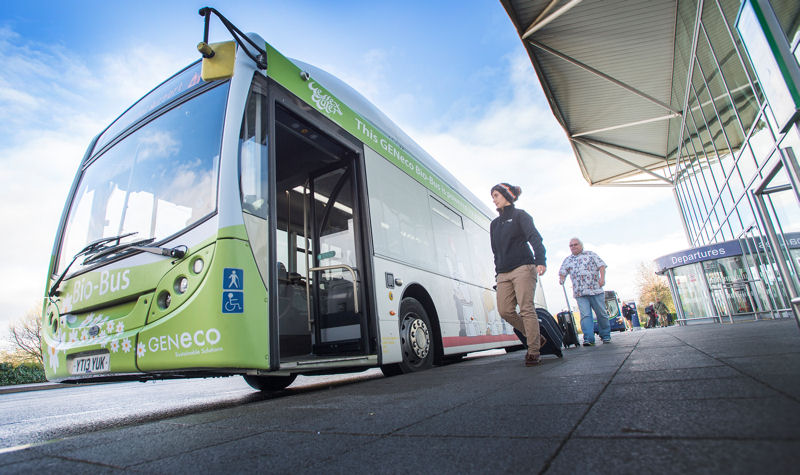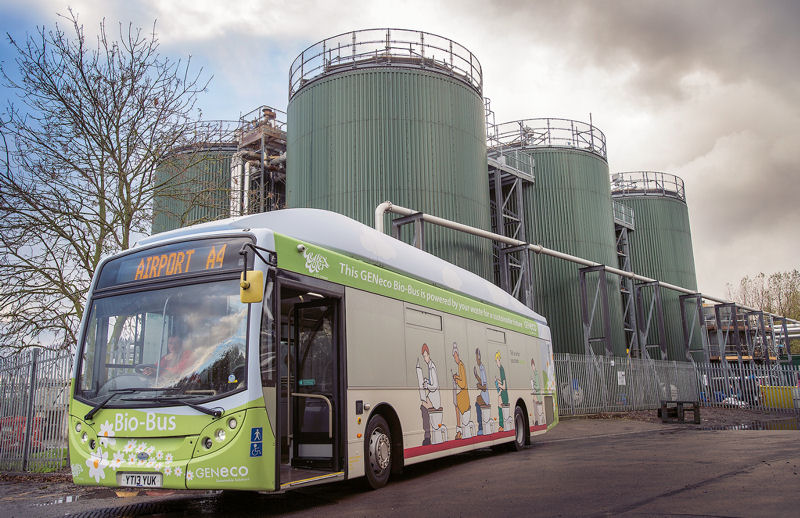
The Bio-Bus runs on biomethane gas as a renewable fuel that helps reduce air pollution and reliance on fossil fuels. Photo courtey of Wessex Water (Bath, England), Julian James Photography.
The green movement is gaining momentum in the United Kingdom (U.K.). On Nov. 20, the Bio-Bus, which runs on biomethane gas, picked up its first passengers.
The 40-seat bus can travel as much as 300 km (186 mi) on a tank of gas and emits 20% to 30% less carbon dioxide than a standard diesel bus. The bus also substantially reduces the amount of other harmful exhaust gases that contribute to air pollution, according to a GENeco (Bristol, England) news release.
The biomethane fuel in the Bio-Bus comes from the Bristol Sewage Treatment Works in Avonmouth, England. Every year the facility, run by GENeco, treats about 75 million m3 (19,815 million gal) of wastewater and 31,777 Mg (35,000 tons) of food waste collected from homes, supermarkets, and food manufacturers. Using anaerobic digestion, the facility transforms this waste into 17 million m3 (4491 million gal) of biomethane, the news release says.
“We’re able to produce enough biomethane to provide a significant supply of gas to the national gas network that’s capable of powering almost 8500 homes as well as fueling the Bio-Bus,” said Mohammed Saddiq, GENeco general manager.
The annual wastewater and food waste produced by five people produces enough biomethane for one 300 km (186 mi) bus journey. Domed tanks on the roof store the compressed gas, and a combustion engine similar to diesel equivalents powers the Bio-Bus, the news release says.

The annual waste from five people produces enough biomethane to fill the fuel tank of the 40-passenger Bio-Bus once, enough for a 300 km journey. The bus now travels a route that carries an average of 46,500 passengers every week. Photo courtesy of Wessex Water, Julian James Photography.
Wessex Water (Bath, England) launched GENeco in 2010 to increase the amount of renewable energy it is able to produce. In 2012, GENeco opened the Bristol Sewage Treatment Works facility as the first collocated food-waste facility at a wastewater works. In 2014, GENeco constructed the gas-to-grid plant at the facility that enables the company to inject biomethane into the U.K.’s national gas grid. The gas-to-grid plant ensures that gas being injected into the grid meets required standards. GENeco also installed a gas refueling station for the Bio-Bus at the facility in 2014, the news release says.
Through anaerobic digestion, collected wastes are decomposed without oxygen for 12 to 18 days at 32°C to 42°C (58°F to 76°F), according to a GENeco infographic. This produces biomethane. A bioscrubber and activated-carbon filters are used to remove impurities such as carbon dioxide and other gases. Propane is added to the biomethane to enrich the gas so it meets the quality and calorific value of natural gas. Enriched biomethane is analyzed and monitored to ensure it meets set standards before being fed into the local gas distribution network, the news release says.
“Gas-powered vehicles have an important role to play in improving air quality in U.K. cities, but the Bio-Bus goes further than that and is actually powered by people living in the local area, including quite possibly those on the bus itself,” Saddiq said. “Using biomethane in this way not only provides a sustainable fuel, but also reduces our reliance on traditional fossil fuels,” he added.
On March 25, First West of England (Bristol) took over operation of the Bio-Bus. The bus operates on a set route between Cribbs Causeway in South Gloucestershire and Stockwood in Bristol. It will run in addition to the normal buses used on the route and help transport the average 46,500 passengers that travel on the bus route every week, according to a First West of England news release.
The bus follows in the tire tracks of the Bio-Bug, a wastewater-powered car released by GENeco in 2010. Read more about the car in the November 2010 WEF Highlights article, “UK Debuts First Wastewater-Powered Car.”
— Jennifer Fulcher, WEF Highlights
Related: Vibration Measurement.








April 2, 2015
Featured